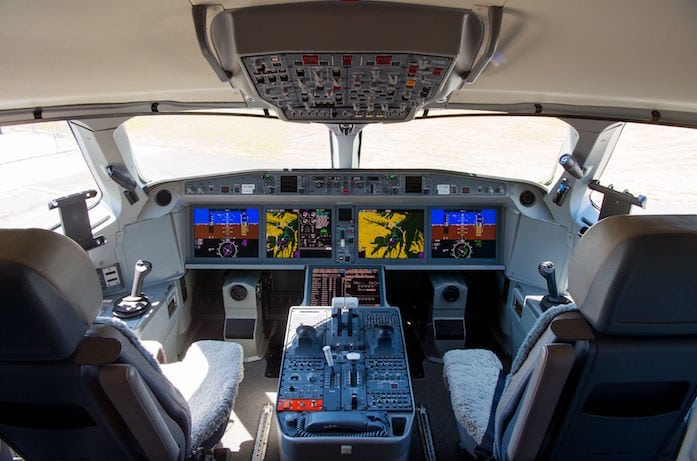
An Airbus A220 cockpit. (Airbus)
At a major international air show such as Farnborough, topics such as avionics embedded processing, certification, ADS-B mandates and more are sometimes overshadowed by major sales of new airplanes, flying displays and other headline-grabbing announcements. Here, we provide an avionics-focused preview of what to expect from the aviation industry’s biggest event of the year.
Boeing NMA
Will Boeing finally officially announce its much anticipated new middle-of-the-market aircraft (NMA) at Farnborough? This is the biggest trending item to watch ahead of Farnborough, as the commercial aviation industry has been anticipating the launch of the NMA by Boeing for several years. It would become Boeing’s first new commercial model since the introduction of the Boeing 747-8 in 2011.
Normally, the announcement of a new model aircraft would lead to an open competition for avionics OEMs, systems integrators and suppliers. However, considering Boeing launched a new business unit focusing on the development and production of avionics technology in July 2017, a lot of the avionics components and systems on the NMA could be developed internally. Boeing plans on adding up to 480 new employees to its avionics subsidiary by 2019.
Digital Transformation at Airbus
Airbus officially integrated Bombardier’s C Series into its aircraft portfolio, re-naming it the Airbus A220. The A220 will also become a part of an intense focus on what Airbus executives described as the company’s “digital transformation” during its pre-Farnborough media briefing.
The focus of the digital transformation for Airbus has occurred in two areas: the continued growth of its SkyWise aircraft data analytics platform and the use of robots and digital three-dimensional digital modeling to design and produce airframes, systems and components.
According to Airbus Commercial Aircraft President Guillaume Faury, in 2018 Airbus will add 500 new employees with data management competencies to its global organization.
F-35 Future Avionics Upgrades?
On the first day of Farnborough, Lockheed Martin will open the event with F-35 Lightning II Program Vice President and General Manager Greg Ulmer discussing the future of the F-35 program.
The future of the program will include updates to the fifth-generation fighter jet’s avionics, including new weapons control functionality and an AI cognitive assistant in the cockpit, according to a program update provided by the OEM at the recent AIAA 2018 forum. There are also plans for Lockheed to incorporate new sensors on the helmet-mounted display.
Industry Consolidation
Farnborough will be one of the first major international shows where the aviation industry witnesses some of the major consolidation that has been occurring over the last year. For example, while one of the industry’s major avionics OEMs, Rockwell Collins, is not exhibiting at Farnborough this year, UTC Aerospace will. UTC recently received EU antitrust approval to acquire Rockwell Collins.
Elbit Systems, which completed its acquisition of Universal Avionics in April, will also be exhibiting at Farnborough.
In the weeks leading up to the show, Boeing announced plans to establish separate commercial and defense joint ventures with Embraer. This could have a major impact on avionics and other component suppliers to both Boeing and Embraer.
“Boeing has already managed to consolidate a lot of buying power, through both unprecedented growth in aircraft production rates and from vertical integration in the supply chain,” said Diogenis Papiomytis, global program director for commercial aviation at Frost & Sullivan.
“This buying power will be of immense help in reducing production costs for Embraer. But, it will also mean that Tier two and three suppliers will be even weaker in dealing with Boeing,” he added.
Boeing also recently acquired Aurora Flight Sciences, which could help integrate some new autonomous technological capabilities into the OEM’s portfolio.
Finally, Northrop Grumman’s presence at Farnborough will feature its expanded portfolio including its recent acquisition of Orbital ATK.
Multicore Processing and System on Chip
Two of the technological trends becoming increasingly prevalent within the commercial avionics space include multicore processing and system on chip technology, according to Cyient, an aerospace engineering services provider based in India.
“Multicore processors and System On Chip (SOC) solutions are one of the major changes we see in commercial avionics,” said Justin Bragan, senior director of business development for the aerospace and defense division of Cyient.
“We have seen these implementations in many military programs, but we are just starting to see widespread use in the commercial market. The advantage of these type of systems is a significant amount of power and utility in an off the shelf solution,” Bragan added.
New Avionics for the F-16?
On the second day of Farnborough, Lockheed Martin will host a press briefing giving an update on what it sees as growing global demand for the F-16. According to the company’s description of the briefing, there is demand from military units across the Middle East, the Mediterranean, Asia and South America to purchase 400 new F-16s within the next several years.
Lockheed Martin’s latest service life extension program (SLEP) introduced modifications for the F-16 that would keep it flying into the 2040s. The latest program included Northrop Grumman’s APG-83 active electronically scanned array fire-control radar, an Elbit Systems of America 6-by-8 center pedestal display and an upgraded mission computer.
Considering Lockheed’s expectation that there is demand for the purchase of 400 new F-16s in the future, that could mean new avionics upgrades being incorporated into the fourth generation fighter jet as well.